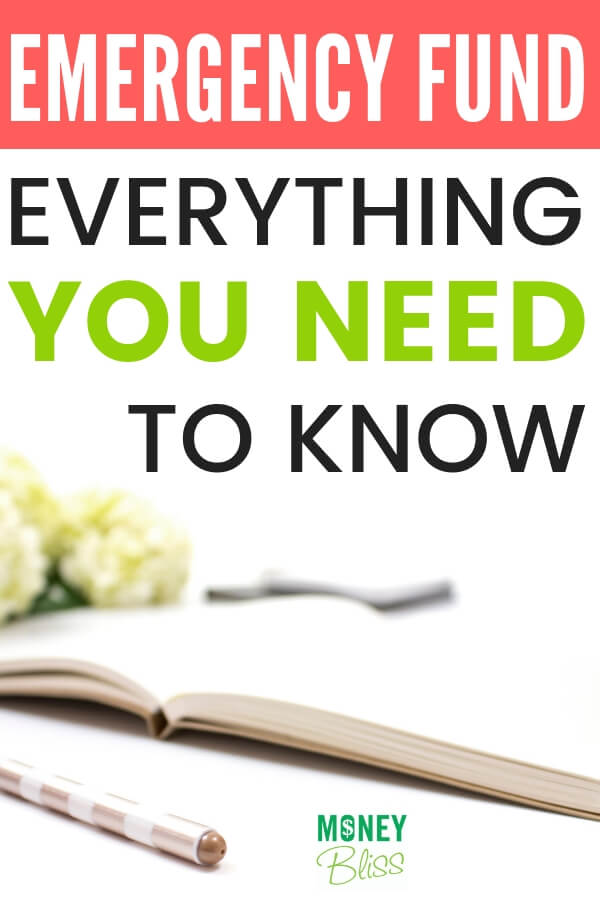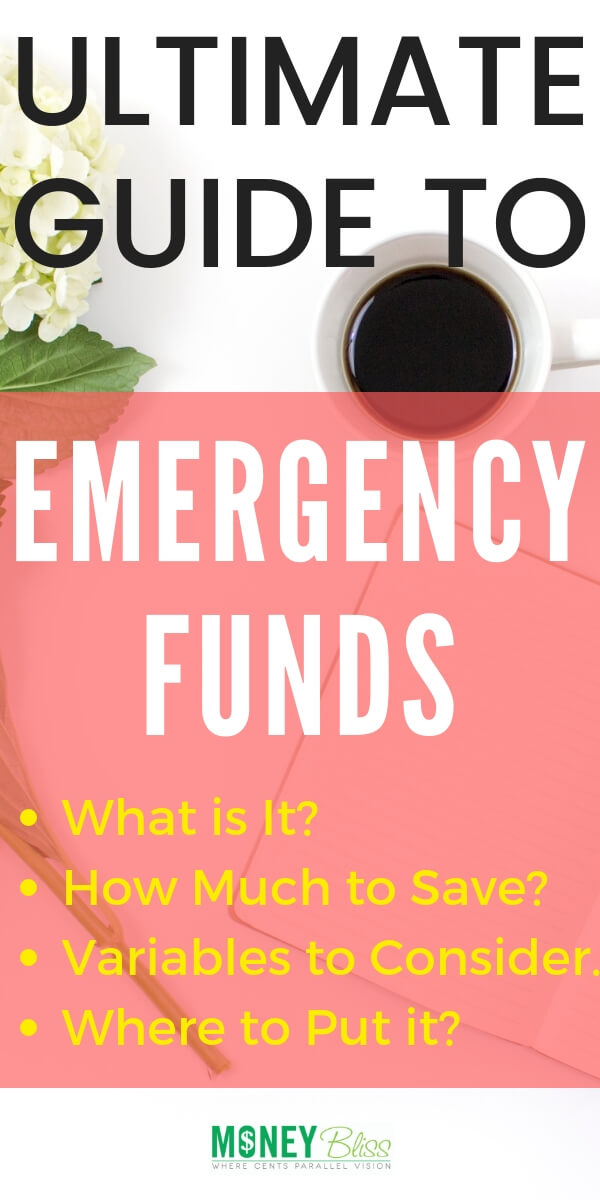Emergency Fund – Everything You Need to Know
This post may contain affiliate links, which helps us to continue providing relevant content and we receive a small commission at no cost to you. As an Amazon Associate, I earn from qualifying purchases. Please read the full disclosure here.
If an unexpected expense arises, you will be able to take care of it and move on. The question is not if an emergency expense will arise, but when it will happen.
However, many don’t understand how to use an emergency fund.
How much money should you have in an emergency fund? Is a $1000 emergency fund enough? Or is $5000 a good emergency fund? What are good examples to use emergency funds?
According the Federal Reserve in 2015, 50% of Americans couldn’t cover a $400 emergency expense out of savings. Even when you look across income levels, the same statistic was hardly varied.
Key Fact – Most Americans do not save and will be in trouble if unexpected expenses arise. Lack of an emergency fund causes many undue stress and debt for many Americans.
So, be prepared and start an emergency savings fund.
Did you know? Emergency money is #2 on the Money Bliss Steps to Financial Freedom!
Now, the big question – how much to save for emergency fund?

Understanding An Emergency Fund
An emergency fund is designed to help you in a true emergency.
Yes, a true emergency. A curve ball out of left field.
Not overspending because you couldn’t say no.
An emergency savings fund is NOT overdraft protection on your checking account.
Also, an emergency fund is not for 3-6 months of expenses or what we call a big sink fund or rainy day fund. Below, we will go more into detail about these longer term savings.
It is for a short term. One time expense.
The emergency fund examples will vary depending where you are on your financial freedom journey. If you are just starting out and beginning your path to managing money better, then your need to use your emergency fund is greater. If you have established sinking funds, then your reliance on an emergency fund is much less.
Truly, emergency money should never need to be used. But, it is there if you need it.
Emergency Fund Examples:

Ultimately, you would never touch your emergency fund. However, the reality of needing at some point is likely.
Here are possible emergency fund examples include:
- Sudden unexpected issues or accident with your car.
- Unexpected home repairs (and the sinking fund doesn’t cover all of it).
- Higher than expected tax bill.
- Travel for family emergencies.
- Expenses that you will be reimbursed for.
Shortly, we will cover how much you need in an emergency fund. But, anything over $5000 saved is your rainy day fund. That 3-6+ month of expenses should cover job losses, local term medical crisis, or more expensive home repairs, etc.
These DON’T qualify as possible emergency fund examples:
- Covering overspending.
- New tires or car registration (that should be budgeted in with sinking funds).
- Last minute getaway or travel with friends.
- New dress for that upcoming event.
- Downpayment for anything.
All in all, when you WANT something and haven’t saved for it; those aren’t reason to dip into your emergency fund.
Now, let’s decide what the appropriate size emergency fund should be.

How much to save for emergency fund?
That is the most common question! How much money to put aside in emergency savings fund? What is the recommended emergency fund size?
How about this? What if this happens?
The minimum recommended emergency fund should be $1,000.
Yes, a minimum of $1,000 set aside just for emergencies.
However, 2% of the annual salary is a better threshold of how much to save for an emergency fund.
The maximum recommended emergency fund size is $5,000.
Depending on the Money Bliss Step you are on, the rest would go to a medical fund, pay off debt, or a big sink fund.
Emergency Fund Size Examples:
- If the annual salary is $75,000, then set aside $1,500 for an emergency fund.
- The combined annual salaries are $115,000, then set aside $2,300.
- If the annual salary is $40,000, then round up and set aside $1,000 for an emergency savings fund.
High School Student
An exception… If you are in high school, a $500 emergency fund will suffice.
Upon graduation and the first real world job (even if isn’t in your career field of choice), start saving to meet the $1000 minimum emergency money threshold.
Related Resource for you: How to Budget Money and Still Enjoy Life
Variables that Impact Your Emergency Fund Size
Before you skip off knowing your dollar amount needed for an emergency fund, consider these variables that could deeply impact how much is needed for your household.
- Expenses to travel to see loved ones
- Past experiences
- Comfort level
Everyone relates to money and thus security in a different way.
After considering the above variables, you need to decide how much an emergency fund should be for your household.
Personally, we had a time period where our emergency savings fund was drained due to an extended family member’s medical emergency. They were in the same state, but our emergency money was drained WAY faster than I ever would have anticipated.
Some was cost of travel (fuel) and eating out. Some of the extra expense was caused by the stress and not being able to accomplish some of the things we relied on to curb our spending – like meal planning. The rest was to actually deal with the situation at hand.
All in all, we learned a valuable lesson and increased our emergency fund account because of our past experiences and comfort level.

Where to Put Emergency Fund
Let’s be honest.
Temptations are everywhere. For many, it is very tempting to spend your emergency fund.
Why? Because money is just sitting there staring at you.
If you have any temptation to spend your emergency money, then put it in an online savings account.
**Do it now**
Here are my three reasons to use an online savings account:
- When looking at bank balances, I don’t see extra money in my account.
- Temptation to spend is gone.
- Ability to access the money in 2-3 business days if needed.
If this is you, don’t delay. Open an online savings account. It will only take a few minutes.
Basic Guidelines for Emergency Fund:

One key factor on the quest to financial freedom is building a solid base to wealth.
By having an emergency fund, you start your foundation to financial freedom.
Here are a few guidelines to help you succeed:
- Set up a separate savings account for the Emergency Fund.
- Fully fund your Emergency Savings Fund.
- Make sure your have emergency money set aside before you pay off debt.
- Make sure it is easily accessible (transfer within the same bank/credit union or within 2-3 days from an internet saving account).
- If an unexpected expense occurs, use money in the Emergency Fund account and then promptly work to put money back into the Emergency Savings Fund again.
Emergency money provides financial security to take care of your household.
Murphy’s law will happen at some point; it is just a matter of when.
Be prepared and start your emergency savings fund (or increase the amount, if necessary).
Emergency Fund vs 3-6 Month Expenses

Big, big difference here.
An emergency fund covers a short term expense.
An example would be a flight to see a loved one,
On the flip side, a Big Sink Fund would cover a minimum of 3-6 months expenses.
For instance, a job loss.
Why the difference?
Simple.
Money set aside for two totally difference purposes. One is short term. The other is long term.
The amount needed to save for each is completely different because they each have difference purposes.
Don’t confuse the two. IN order to build a strong foundation with money it is imperative to take one step at a time.
In this case, paying off debt and starting a medical fund comes before a big sink fund (or 3-6 months of expenses).
Related Posts:
Start an Emergency Fund – Are you ready?

Still a little overwhelmed by the prospect of saving money?
You really shouldn’t be.
Just figure out how much you can put in your emergency fund per month until it is fully funded. Then, if for some reason, you use some of your emergency fund, figure out how to replenish your emergency fund.
Ultimately, you want your emergency fund in place sooner than later. If possible, try to fund it within 30-90 days. That is your #1 priority during that time.
Not sure you can make it happen, then learn more about how to make a budget.
Also, find plenty more information in Save Money Learning Center.
Up Next:

Did the post resonate with you?
More importantly, did I answer the questions you have about this topic? Let me know in the comments if I can help in some other way!
Your comments are not just welcomed; they’re an integral part of our community. Let’s continue the conversation and explore how these ideas align with your journey towards Money Bliss.

